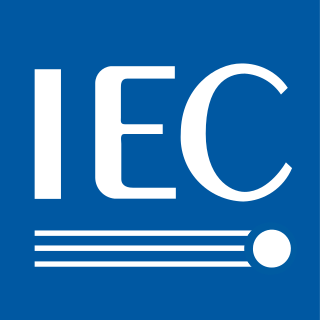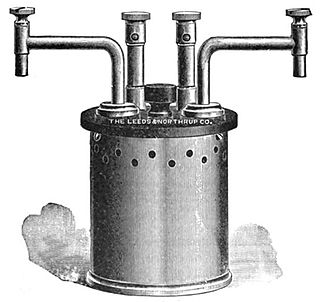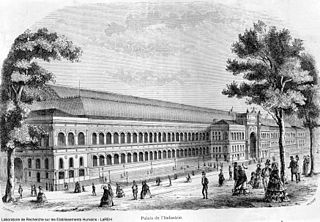Related Research Articles

The ampere, often shortened to amp, is the unit of electric current in the International System of Units (SI). One ampere is equal to 1 coulomb (C) moving past a point per second. It is named after French mathematician and physicist André-Marie Ampère (1775–1836), considered the father of electromagnetism along with Danish physicist Hans Christian Ørsted.
The centimetre–gram–second system of units is a variant of the metric system based on the centimetre as the unit of length, the gram as the unit of mass, and the second as the unit of time. All CGS mechanical units are unambiguously derived from these three base units, but there are several different ways in which the CGS system was extended to cover electromagnetism.

The International Electrotechnical Commission is an international standards organization that prepares and publishes international standards for all electrical, electronic and related technologies – collectively known as "electrotechnology". IEC standards cover a vast range of technologies from power generation, transmission and distribution to home appliances and office equipment, semiconductors, fibre optics, batteries, solar energy, nanotechnology and marine energy as well as many others. The IEC also manages four global conformity assessment systems that certify whether equipment, system or components conform to its international standards.

The joule is the unit of energy in the International System of Units (SI). It is equal to the amount of work done when a force of one newton displaces a mass through a distance of one metre in the direction of that force. It is also the energy dissipated as heat when an electric current of one ampere passes through a resistance of one ohm for one second. It is named after the English physicist James Prescott Joule (1818–1889).

The volt is the unit of electric potential, electric potential difference (voltage), and electromotive force in the International System of Units (SI).

The metric system is a decimal-based system of measurement. The current international standard for the metric system is the International System of Units, in which all units can be expressed in terms of seven base units: the metre (m), kilogram (kg), second (s), ampere (A), kelvin (K), mole (mol), and candela (cd). These can be made into larger or smaller units with the use of metric prefixes.

The coulomb (symbol: C) is the unit of electric charge in the International System of Units (SI). It is equal to the electric charge delivered by a 1 ampere current in 1 second and is defined in terms of the elementary charge e, at about 6.241509×1018 e.
The oersted is the coherent derived unit of the auxiliary magnetic field H in the centimetre–gram–second system of units (CGS). It is equivalent to 1 dyne per maxwell.

The farad (symbol: F) is the unit of electrical capacitance, the ability of a body to store an electrical charge, in the International System of Units (SI), equivalent to 1 coulomb per volt (C/V). It is named after the English physicist Michael Faraday (1791–1867). In SI base units 1 F = 1 kg−1⋅m−2⋅s4⋅A2.
The maxwell is the CGS (centimetre–gram–second) unit of magnetic flux.

In physics, the magnetomotive force is a quantity appearing in the equation for the magnetic flux in a magnetic circuit, Hopkinson's law. It is the property of certain substances or phenomena that give rise to magnetic fields: where Φ is the magnetic flux and is the reluctance of the circuit. It can be seen that the magnetomotive force plays a role in this equation analogous to the voltage V in Ohm's law, V = IR, since it is the cause of magnetic flux in a magnetic circuit:
- where N is the number of turns in a coil and I is the electric current through the coil.
- where Φ is the magnetic flux and is the magnetic reluctance
- where H is the magnetizing force and L is the mean length of a solenoid or the circumference of a toroid.
In physics, the weber is the unit of magnetic flux in the International System of Units (SI). The unit is derived from the relationship 1 Wb = 1 V⋅s (volt-second). A magnetic flux density of 1 Wb/m2 is one tesla.

Giovanni Giorgi was an Italian physicist and electrical engineer who proposed the Giorgi system of measurement, the precursor to the International System of Units (SI).

The ohm is the unit of electrical resistance in the International System of Units (SI). It is named after German physicist Georg Ohm. Various empirically derived standard units for electrical resistance were developed in connection with early telegraphy practice, and the British Association for the Advancement of Science proposed a unit derived from existing units of mass, length and time, and of a convenient scale for practical work as early as 1861.
The vacuum magnetic permeability is the magnetic permeability in a classical vacuum. It is a physical constant, conventionally written as μ0. It quantifies the strength of the magnetic field induced by an electric current. Expressed in terms of SI base units, it has the unit kg⋅m⋅s−2·A−2. It can be also expressed in terms of SI derived units, N·A−2.
The abohm is the derived unit of electrical resistance in the emu-cgs (centimeter-gram-second) system of units. One abohm corresponds to 10−9 ohms in the SI system of units, which is a nanoohm.
The metre, kilogram, second system of units, also known more briefly as MKS units or the MKS system, is a physical system of measurement based on the metre, kilogram, and second (MKS) as base units. Distances are described in terms of metres, mass in terms of kilograms and time in seconds. Derived units are defined using the appropriate combinations, such as velocity in metres per second. Some units have their own names, such as the newton unit of force which is the combination kilogram metre per second squared.
The International System of Electrical and Magnetic Units is an obsolete system of units used for measuring electrical and magnetic quantities. It was proposed as a system of practical international units by unanimous recommendation at the International Electrical Congress, discussed at other Congresses, and finally adopted at the International Conference on Electric Units and Standards in London in 1908. It was rendered obsolete by the inclusion of electromagnetic units in the International System of Units (SI) at the 9th General Conference on Weights and Measures in 1948.

The first International Exposition of Electricity ran from 15 August 1881 through to 15 November 1881 at the Palais de l'Industrie on the Champs-Élysées in Paris, France. It served to display the advances in electrical technology since the small electrical display at the 1878 Universal Exposition. Exhibitors came from the United Kingdom, United States, Germany, Italy and the Netherlands, as well as from France. As part of the exhibition, the first International Congress of Electricians presented numerous scientific and technical papers, including definitions of the standard practical units volt, ohm and ampere.

The history of the metric system began during the Age of Enlightenment with measures of length and weight derived from nature, along with their decimal multiples and fractions. The system became the standard of France and Europe within half a century. Other measures with unity ratios were added, and the system went on to be adopted across the world.
References
- 1 2 Petley, B.W. (1994–95). "A Brief History of the Electrical Units to 1964" . Metrologia. 31: 483.
- ↑ "Overview: Summary". IEC History. International Electrotechnical Commission. Archived from the original on 2018-04-24. Retrieved 2018-04-19.
- 1 2 3 4 5 "Historical background". International Electrotechnical Commission . Retrieved 10 April 2018.
- 1 2 3 4 Lagerstrom, L.R. (1992). Constructing uniformity: The standardization of international electromagnetic measures, 1860-1912 (doctoral dissertation). University of California, Berkeley.p. 77
- ↑ Congrès International des électriciens, Paris 1881. Paris: G. Masson. 1882. (in French)
- ↑ Tunbridge, P. (1992). Lord Kelvin: His Influence on Electrical Measurements and Units. Peter Peregrinus: London. p. 34. ISBN 978-0-86341-237-0.
- ↑ First Report of the Committee for the Selection and Nomenclature of Dynamical and Electrical Units. Forty-third Meeting of the British Association for the Advancement of Science. London: John Murray. 1874. p. 223. Retrieved 8 April 2018. (Committee members: Professor Joseph David Everett (reporter), Sir W Thomson, Professor GC Foster, Professor JC Maxwell, Mr GJ Stoney, Professor Flemming Jenkin, Dr. CW Siemens, Mr FJ Bramwell)
- 1 2 Tunbridge, P. (1992). Lord Kelvin: His Influence on Electrical Measurements and Units. Peter Peregrinus: London. pp. 35–39. ISBN 978-0-86341-237-0.
- ↑ Martin, T.C. (1894). "History of the Congress". Proceedings of the International Electrical Congress held in the City of Chicago August 21st to 25th, 1893. New York: American Institute of Electrical Engineers. p. xxii.
- ↑ Proceedings of the International Electrical Congress. New York: American Institute of Electrical Engineers. 1894.
- ↑ Carhart, H.S. (18 Oct 1895). "Proceedings of the International Electrical Congress, Chicago, 1893 [review]". Science. 2 (42): 525–526. Bibcode:1895Sci.....2..525C. doi:10.1126/science.2.42.525.
- 1 2 Tunbridge, P. (1992). Lord Kelvin: His Influence on Electrical Measurements and Units. Peter Peregrinus: London. p. 46. ISBN 978-0-86341-237-0.
- ↑ Congrès International d'électricité (in French). Paris: Gauthier-Villars. 1901.
- 1 2 3 Kennelly, Arthur E. (1933). "Conference of the Symbols, Units and Nomenclature (S. U. N.) Commission of the International Union of Pure and Applied Physics (I. P. U.), at Paris, in July, 1932, and Its Results". Proceedings of the National Academy of Sciences of the United States of America. 19 (1): 144–149. Bibcode:1933PNAS...19..144K. doi: 10.1073/pnas.19.1.144 . JSTOR 85786. PMC 1085894 . PMID 16587728.
- ↑ Kennelly, Arthur E. (5 March 1904). "A historical sketch of International Electrical Congresses". Electrical World and Engineer. Vol. 43. p. 468. Retrieved 20 April 2018.
- ↑ "Rapport de la Commission des Unités". Congrès International d'électricité (in French). Paris: Paris, Gauthier-Villars. 1901. p. 384.
- ↑ Kennelly, Arthur E. (1933). "Conference of the Symbols, Units and Nomenclature (S. U. N.) Commission of the International Union of Pure and Applied Physics (I. P. U.), at Paris, in July, 1932, and Its Results". Proceedings of the National Academy of Sciences of the United States of America. 19 (1): 144–9. Bibcode:1933PNAS...19..144K. doi: 10.1073/pnas.19.1.144 . JSTOR 85786. PMC 1085894 . PMID 16587728.
- ↑ "The International Electrical Congress". Science. 20 (500): 156–157. 29 Jul 1904. Bibcode:1904Sci....20..156.. doi:10.1126/science.20.500.156. PMID 17740824.
- ↑ Transactions of the Transactions of the International Electrical Congress, St. Louis, 1904. Albany, NY: J.B. Lyon. 1905.
- 1 2 "Founding of the IEC". International Electrotechnical Commission . Archived from the original on 13 April 2018. Retrieved 13 April 2018.
- ↑ Ministère des Affaires Étrangères (1882). Conférence international pour la détermination des unités électriques. Paris: Imprimerie Nationale. Retrieved 17 April 2018. (in French).
- ↑ "Congress". Report of the United States Commissioners to the Universal Exposition of 1889 at Paris. Washington, DC: Government Printing Office. 1891. pp. 18–20. Retrieved 12 April 2018.
- 1 2 3 Tunbridge, P. (1992). Lord Kelvin: His Influence on Electrical Measurements and Units. Peter Peregrinus: London. p. 42. ISBN 978-0-86341-237-0.
- ↑ Jayson, J.S. (2015). "The Daniell Cell, Ohm's Law and the Emergence of the International System of Units". American Journal of Physics. 82 (1): 63. arXiv: 1512.07306 . Bibcode:2014AmJPh..82...60J. doi:10.1119/1.4826445. S2CID 119278961.
- ↑ Hering, Carl (1891). "Report of the delegation to the Frankfort electrical Congress". Transactions of the American Institute of Electrical Engineers. 8: 544–547. doi:10.1109/T-AIEE.1891.5570160. S2CID 51638823.
- ↑ Bracco, Christian (2014). "Einstein and Besso: From Zürich to Milano". p. 8. arXiv: 1412.6981 [physics.hist-ph].
- 1 2 Lagerstrom, L.R. (1992). Constructing uniformity: The standardization of international electromagnetic measures, 1860-1912 (doctoral dissertation). University of California, Berkeley. p. 134
- ↑ International Elektrotechniker-Congress. Bericht uber die Verbandlungen der Hauptversammlungen. Frankfurt am Main: Johannes Alt, 1892.
- ↑ "Table of Contents of papers presented in the sections" (PDF) (in German). Retrieved 21 April 2018.
- ↑ "System of measurement units". Engineering and Technology History Wiki. 24 April 2012. Retrieved 13 April 2018.
- 1 2 Lagerstrom, L.R. (1992). Constructing uniformity: The standardization of international electromagnetic measures, 1860-1912 (doctoral dissertation). University of California, Berkeley. pp. 198–200.
- ↑ Fleming, John Ambrose (1911). . In Chisholm, Hugh (ed.). Encyclopædia Britannica . Vol. 27 (11th ed.). Cambridge University Press. pp. 738–745, see page 742.
An Electrical Congress was held in Chicago, U.S.A. in August 1893, to consider....after deliberation for six days, was a unanimous agreement to recommend the following resolutions as the definition of practical international units...
- 1 2 "The International Electrotechnical Congress of Turin". Transactions of the American Institute of Electrical Engineers. 30 (3): 2519–2533. 1911. doi:10.1109/T-AIEE.1911.4768387.
- ↑ "International Electrical Congress, San Francisco, 1915". Proceedings of the American Institute of Electrical Engineers. 33 (7): 216–217. 1914. doi: 10.1109/PAIEE.1914.6660692 .
- ↑ Tunbridge, P. (1992). Lord Kelvin: His Influence on Electrical Measurements and Units. Peter Peregrinus: London. p. 53. ISBN 978-0-86341-237-0.
- 1 2 Lagerstrom, L.R. (1992). Constructing uniformity: The standardization of international electromagnetic measures, 1860-1912 (doctoral dissertation). University of California, Berkeley.pp. 243-244
- ↑ Lagerstrom, L.R. (1992). Constructing uniformity: The standardization of international electromagnetic measures, 1860-1912 (doctoral dissertation). University of California, Berkeley.p. 245
- ↑ Internationale Konferenz über Elektrische Masseinheiten (1906). Verhandlungen der Internationalen konferenz über elektrische masseinheiten abgehalten in der Physikalischtechnischen reichsanstalt zu Charlottenburg vom 23. bis 25. oktober 1905. Reichsdruckerei. Retrieved 17 April 2018.
- ↑ Lagerstrom, L.R. (1992). Constructing uniformity: The standardization of international electromagnetic measures, 1860-1912 (doctoral dissertation). University of California, Berkeley.p. 351
- 1 2 3 4 Tunbridge, P. (1992). Lord Kelvin: His Influence on Electrical Measurements and Units. Peter Peregrinus: London. pp. 49–51. ISBN 978-0-86341-237-0.
- ↑ Lagerstrom, L.R. (1992). Constructing uniformity: The standardization of international electromagnetic measures, 1860-1912 (doctoral dissertation). University of California, Berkeley.p. 247
- ↑ Congrès international des applications de l'électricité Marseille (3 vol.) (in French). Paris: Gauthier-Villars. 1909.